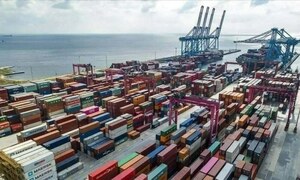US energy firms are scrambling to finish a slew of pipelines that will unleash rich reserves of shale gas in Pennsylvania, West Virginia and Ohio as the nation prepares to become one of the world's top natural gas exporters. The pipelines are expected to boost output from shale fields in the three states by giving producers access to new domestic and international markets.
Those states could supply about a third of all US natural gas once the pipeline expansion is complete, up from about 25 percent now, according to projections from the US Energy Information Administration (EIA). The network will bring cheaper fuel supplies for power generation and industry being built in the eastern half of Canada and the United States, especially along the US Gulf Coast. It would also transport the huge volumes needed to feed facilities that chill the gas to liquid so it can be shipped internationally.
The construction addresses a lack of pipeline capacity that has stunted development of two of the largest shale fields in the United States, the Marcellus and Utica formations. The lines should allow output to increase from both fields by about 50 percent in the next two years, according to the EIA. Gas from the Marcellus and Utica is among the cheapest in the country.
Among the largest projects under construction are Energy Transfer Partners LP's (ETP) Rover; TransCanada Corp's Leach XPress; and Williams Cos Inc's Atlantic Sunrise. Those lines will move gas out of these shale basins to markets in Canada, the US Midwest and Southeast, including expected connections to Gulf Coast export terminals.
The completion of the lines will be a welcome boon for the firms and their investors after a tough couple of years. A slump in international energy prices led to reduced demand for new oil and gas pipeline capacity from producers. ETP and other firms were also hit by a growing protest movement of environmentalists, Native American rights groups and US military veterans, which delayed big ticket projects such as the Dakota Access Pipeline.
Contractors building ETP's $4.2 billion Rover gas pipeline from Pennsylvania to Ontario will hire up to 15,000 workers during construction of the line, expected to be completed by late 2017, according to ETP spokesperson. Just over a decade ago - before technological innovation unleashed huge oil and gas supplies trapped in shale rock - US gas production from conventional fields was in decline and the nation was expected to become one of the world's biggest importers of natural gas.
High prices for fuel encouraged petrochemical and chemical industries to move abroad. Now, amid the shale revolution, the nation is producing 50 percent more gas, making it the world's biggest producer as energy firms opened up new energy frontiers across the United States. Prices for gas have averaged less than $3 per million British thermal units over the past two years, a third of the price in 2005, and are expected to remain mostly below that level through at least 2023, based on current futures trading on the New York Mercantile Exchange.
That cheap and ample supply motivated industrial firms to spend billions to build and expand manufacturing facilities mostly along the US Gulf Coast but also in the Midwest, such as chemical companies that use gas to make plastics.
Royal Dutch Shell PLC last year agreed to build a multibillion-dollar petrochemical complex near Pittsburgh to be close to the source of the Marcellus and Utica gas. It will employ about 6,000 workers to build the facility and is expected to create about 600 permanent jobs when completed. Abundant supply has also sparked interest from many countries in buying US LNG exports. The United States is expected to become a net exporter of gas this year or next for the first time since 1957 on the back of those rising LNG exports as well as pipeline flows to Mexico.
At the center of activity in both the Marcellus and Utica is Pennsylvania, which accounts for about 20 percent of US gas production, making it bigger than any state other than Texas. Pennsylvania's output rocketed from 0.5 billion cubic feet per day (bcfd) in 2006 to 14.5 bcfd in 2016, according to the EIA and the Pennsylvania Department of Environmental Protection.
One billion cubic feet is enough to fuel about 5 million homes - or every house in Pennsylvania. Still, the state has the potential to pump a lot more gas as more pipelines provide producers with avenues to new markets. At least five pipelines capable of transporting over seven bcfd from the Marcellus and Utica are scheduled to open in 2017, with five more due for completion in 2018, capable of moving another five bcfd.
Pipeline capacity from Pennsylvania, Ohio and West Virginia was around 23 bcfd in 2016, according to the EIA and Thomson Reuters data. If all pipes under construction are completed, that would rise to more than 35 bcfd. The pipeline construction and gas production expansion mean billions of dollars in new investments in Pennsylvania and hiring that will extend well beyond the energy sector, said Ryan Unger, CEO of the Team Pennsylvania Foundation, a non-profit foundation focused on public-private partnerships.
"We are in a position now where we can maximise the state's resources to create good, stable jobs in Pennsylvania," Unger said. Some of the biggest drillers in Pennsylvania stand to benefit most from increasing pipeline capacity. They include units of Chesapeake Energy Corp, Cabot Oil & Gas Corp , Range Resources Corp and EQT Corp.
Cabot sees an opportunity in the "underserved" markets of the north-east, said spokesman George Stark. "We'd love to see a pipeline build-out to get Pennsylvania gas to New England," he said. Those four companies together expect to spend an estimated $4.8 billion on US drilling and well completions in 2017, up about 61 percent from what they spent in 2016, according to a capital expenditure analysis by Cowen & Co.
The US started to export LNG from the lower 48 states in 2016; five additional export terminals are expected to open by 2020 to export LNG to large markets in Asia, including China and Japan. Those terminals could make the US the world's third largest exporter of natural gas by 2018, according to an EIA projection. Most of the pipeline infrastructure in the Marcellus and Utica was built before the shale revolution, when the region produced just 3 percent of the nation's gas.
Those lines were designed largely to bring gas into the region - not out of it - as customers in Pennsylvania and other nearby states used gas from Texas and the Gulf Coast. The new lines aim instead to take gas from Pennsylvania to markets world-wide. Almost a third of the wells drilled in Pennsylvania since 2004 were inactive because of a lack of pipelines to transport the gas, according to a report prepared last year by a task force created by Pennsylvania Governor Tom Wolf. "Drilling for gas in Pennsylvania has far outpaced the development of the infrastructure needed to get that gas to markets," the task force said in the report. "The primary challenge the industry faces now is to get the gas around or out of Pennsylvania."
BR100
11,859
Decreased By
-7.5 (-0.06%)
BR30
35,895
Increased By
198 (0.55%)
KSE100
113,801
Decreased By
-347.1 (-0.3%)
KSE30
35,830
Decreased By
-122.3 (-0.34%)

























Comments
Comments are closed.